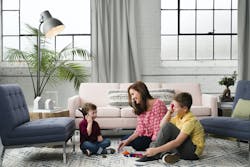Milliken’s New High-Performance Fabric Lets Users Breathe Deeper
Enter Breathe by Milliken. The new performance fabric provides exceptional stain resistance as naturally as possible. According to LeAnne Flack, marketing manager at Milliken, “The importance of Breathe is to [perform] with a minimal amount of chemistry. Really getting back to nature and creating [a fabric that is] fiber-forward.”
Spearheaded by Flack and Dr. Emily W. Michaels, Ph.D., research manager of engineered performance products at Milliken, the two moms aimed to create a product that could withstand the wear and tear of kids, pets, and other everyday use without harming indoor air quality.
“There’s such a trend in the marketplace of regulatory knowledge and being socially responsible with the materials that we use,” Michaels said. “That’s something that Milliken has always taken very seriously as long as the company has been in existence. One of the primary founding principles has been to be a good environmental partner and a good social partner with all of the consumers that we work with.”
Here, i+s helps explain the more scientific language used to explain the inner workings of Breathe by Milliken.
What is it?
Breathe is a performance fabric that is free of fluorine and added formaldehydes. It doesn’t emit VOCs which can harm indoor air quality. Made of natural or recycled fibers and a plant-based water repellent, it can repel or make many everyday stains easily cleanable.
How did it come about?
Noticing a hole in the market for products that are both high-performing and sustainable, Flack and Michaels decided to head to the lab to create a new line for Milliken. “It was a lot of lab work,” Flack noted. “We didn’t really see something [on the market] that you could have on cotton as well as thick polyesters that was fluorine-free.”
How was it made?
This collection was created by looking for a natural solution to high-performance fabrics, right down to the yarn fibers. From there, a wide variety of compounds were tested to discover the best repellency solution.
“There are different classes of chemistry that provide repellency,” Michaels explained. “There are the fluorine class which are heavily scrutinized; there are waxes and hydrophobic emulsions that provide repellency. It’s all about putting the chemistry down that can provide the right chain length, so that the water can bead up and roll off. Those are the things we look at in the lab. We’ll look at surface tension and contact angles. So when you think about things that will provide repellency, you think about things that are naturally anti-water, like a wax. It will lead you down to different categories of compounds.”
From there, the Milliken team tested hundreds of combinations before arriving at their final plant-based solution.
What certifications does it pass?
Every product in the Breathe collection has been GREENGUARD GOLD certified. Additionally, they pass all third-party industry protocols for water repellency, soil release, spot cleaning, colorfastness, abrasion resistance, and piling, as well as CAL117 (CA TB 117-2013: Cover fabric flammability) requirements without flame-retardant chemicals.
About the Author

Kadie Yale
Former Editor-in-Chief
Kadie Yale holds a BA in Industrial Design from San Francisco State University and a MA in Decorative Art History and Theory from Parsons the New School. In her role as editor-in-chief from 2015-2018, she led the interiors+sources team in creating relevant content that touches on sustainability, universal design, science, and the role of design in society.
